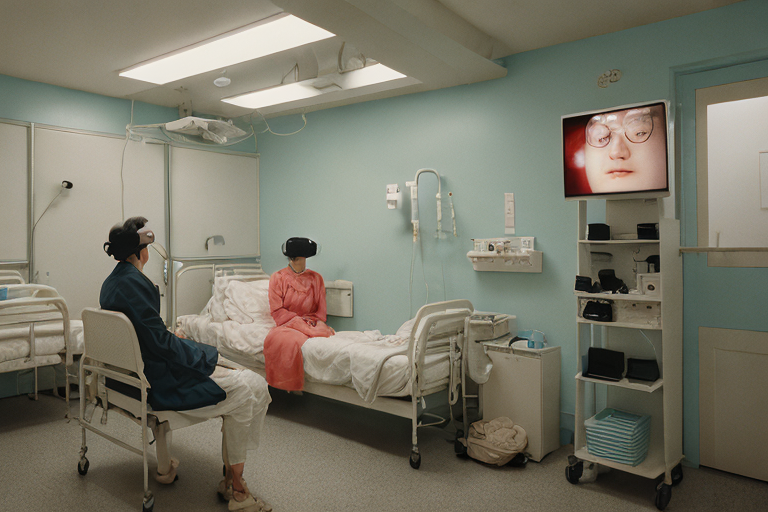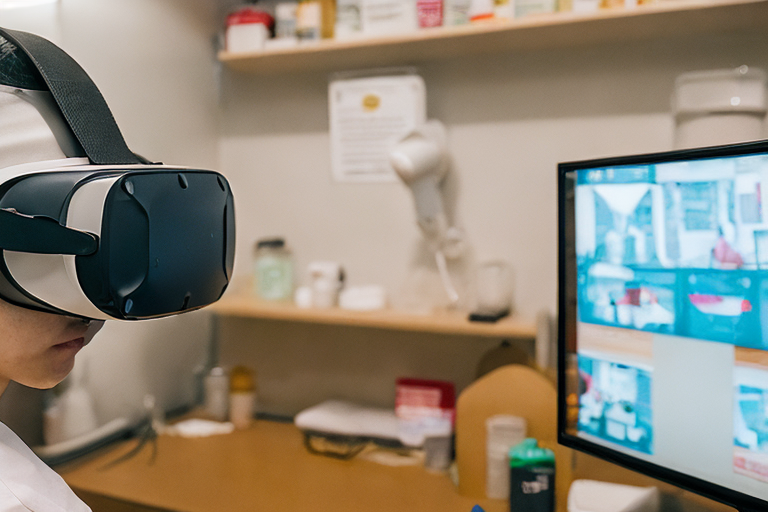공공보건산업에서 가상 현실(VR) 질병 예방 및 제어 개선(Virtual Reality in the Public Health …
본문

가상현실(VR)은 공중보건 산업을 포함한 다양한 산업을 변화시킬 수 있는 기술로 주목받고 있습니다. VR은 몰입적이고 상호 작용적인 경험을 제공함으로써 질병의 예방과 통제를 개선하여 의료 서비스에 더 접근하기 쉽고 효과적으로 만들 수 있습니다.
VR이 효과적임이 입증된 분야 중 하나는 질병 예방 및 건강 증진 분야입니다. 예를 들어, VR은 유해 물질에 노출되거나 부상이나 질병의 위험을 증가시킬 수 있는 상황과 같은 위험한 시나리오를 시뮬레이션하는 데 사용될 수 있습니다. 이러한 시뮬레이션에 개인을 몰입시킴으로써 노출 위험을 줄이고 질병을 예방하는 방법을 배울 수 있습니다. 게다가, VR은 또한 전반적인 건강을 향상시키고 질병을 예방하는 데 도움을 줄 수 있는 운동, 건강한 식사, 스트레스 관리와 같은 건강한 행동에 대해 개인을 교육하는 데 사용될 수 있습니다.
한국에서 공중 보건 산업은 이미 VR 기술을 채택하기 시작했습니다. 예를 들어, 한국의 국립 암 센터는 암 연구와 치료 노력에서 VR을 구현했습니다. 이 센터는 VR을 사용하여 수술을 시뮬레이션하여 환자와 의사 모두에게 현실적이고 상호 작용적인 경험을 제공합니다. 이 기술은 침습적 시술의 필요성을 줄이고 의사가 복잡한 수술을 더 잘 이해하고 준비할 수 있도록 함으로써 환자 관리를 개선하는 데 도움이 됩니다.

한국의 공중 보건 산업에서 VR을 사용하는 또 다른 예는 정신 건강에 있습니다. 서울대학교 병원은 불안과 공포증을 가진 환자들을 위한 VR 기반 노출 치료 프로그램을 개발했습니다. 환자를 불안감을 유발하는 상황을 시뮬레이션하는 가상 환경에 노출시킴으로써 환자는 두려움을 극복하고 상태의 증상을 줄이는 방법을 배울 수 있습니다.
결론적으로, VR은 질병을 예방하고 통제할 수 있는 새롭고 혁신적인 방법을 제공함으로써 공중 보건 산업에 혁명을 일으킬 수 있는 잠재력을 가지고 있습니다. 몰입적이고 상호 작용적인 경험을 제공함으로써, VR은 개인이 건강한 행동에 대해 배우고, 해로운 상황에 노출되는 위험을 줄이고, 환자 치료를 개선하도록 도울 수 있습니다. 한국에서는 공중 보건 산업이 이미 VR 기술을 채택하기 시작했고, 기술이 계속 발전함에 따라, 우리는 미래에 훨씬 더 영향력 있는 애플리케이션을 볼 수 있을 것으로 기대할 수 있습니다.
가상 현실은 질병을 예방하고 통제하는 새롭고 혁신적인 방법을 제공함으로써 공중 보건 산업에 혁명을 일으킬 수 있는 잠재력을 가지고 있습니다. 실제 시나리오를 시뮬레이션함으로써 VR은 의료 전문가를 교육하고, 대중에게 건강 문제에 대해 교육하며, 심지어 특정 상태의 진단 및 치료를 돕는 데 사용될 수 있습니다.

공중 보건 산업에서 VR이 사용되는 한 가지 예는 한국에 있습니다. 한국 정부는 최근 질병 예방과 통제를 개선하기 위한 VR 계획을 시작했습니다. 이 계획에는 결핵 병동의 VR 시뮬레이션이 포함되어 있으며, 이는 의료 종사자들에게 질병을 다루는 적절한 절차를 교육하는 데 사용됩니다. 시뮬레이션은 시뮬레이션된 환자 상호 작용 및 응급 시나리오를 포함하여 가능한 한 현실적으로 설계되었습니다.
VR은 의료 전문가를 교육하는 것 외에도 대중에게 건강 문제에 대해 교육하는 데도 사용될 수 있습니다. 예를 들어, VR은 사람들이 잠재적인 위험을 이해하고 자신을 보호하기 위한 조치를 취할 수 있도록 감염병의 확산을 시뮬레이션하는 데 사용될 수 있습니다. VR은 또한 환자가 집을 떠나지 않고 의료 전문가로부터 정보와 지원을 받을 수 있는 가상 의료 클리닉을 만드는 데 사용될 수 있습니다.

공중 보건 산업에서 VR의 또 다른 잠재적인 사용은 특정 조건의 진단 및 치료에 있습니다. 예를 들어, VR은 실제 시나리오를 시뮬레이션하고 환자가 가상 치료사와 상호 작용할 수 있도록 함으로써 정신 건강 상태를 진단하는 데 도움이 될 수 있습니다. VR은 또한 운동을 시뮬레이션하고 환자가 연습하고 진행 상황을 모니터링할 수 있도록 함으로써 신체 재활을 돕는 데 사용될 수 있습니다.
결론적으로, 공중 보건 산업에서 VR의 사용은 질병을 예방하고 통제하는 방법에 혁명을 일으킬 수 있는 잠재력을 가지고 있습니다. 실제 시나리오를 시뮬레이션하고 실습 교육 및 교육을 제공하는 기능을 통해 VR은 의료 전문가의 기술을 향상시키고 대중이 자신의 건강을 통제할 수 있도록 할 수 있는 잠재력을 가지고 있습니다. VR 기술이 계속 발전함에 따라, 우리는 앞으로 공중 보건 산업에서 VR의 혁신적인 사용을 점점 더 많이 보게 될 것입니다.
Virtual reality (VR) has been gaining attention as a technology that can transform various industries, including the public health industry. By providing an immersive and interactive experience, VR can help improve the prevention and control of diseases, making healthcare more accessible and effective.
One area where VR has proven to be effective is in disease prevention and health promotion. For example, VR can be used to simulate dangerous scenarios, such as exposure to harmful substances or situations that can increase the risk of injury or disease. By immersing individuals in these simulations, they can learn how to reduce the risk of exposure and prevent disease. Additionally, VR can also be used to educate individuals on healthy behaviors, such as exercise, healthy eating, and stress management, which can help improve overall health and prevent disease.
In South Korea, the public health industry has already started to adopt VR technology. The National Cancer Center in South Korea, for example, has implemented VR in its cancer research and treatment efforts. The center uses VR to simulate surgeries, providing a realistic and interactive experience for both patients and physicians. This technology helps improve patient care by reducing the need for invasive procedures and enabling physicians to better understand and prepare for complex surgeries.
Another example of the use of VR in the public health industry in South Korea is in mental health. The Seoul National University Hospital has developed a VR-based exposure therapy program for patients with anxiety and phobia. By exposing patients to virtual environments that simulate the situations that trigger their anxiety, they can learn to overcome their fear and reduce the symptoms of their condition.
In conclusion, VR has the potential to revolutionize the public health industry by providing new and innovative ways to prevent and control diseases. By providing an immersive and interactive experience, VR can help individuals learn about healthy behaviors, reduce the risk of exposure to harmful situations, and improve patient care. In South Korea, the public health industry has already started to adopt VR technology, and as the technology continues to evolve, we can expect to see even more impactful applications in the future.
Virtual reality has the potential to revolutionize the public health industry by providing new and innovative ways to prevent and control diseases. By simulating real-life scenarios, VR can be used to train healthcare professionals, educate the public about health issues, and even help with the diagnosis and treatment of certain conditions.
One example of VR being used in the public health industry is in South Korea. The South Korean government has recently launched a VR initiative aimed at improving disease prevention and control. The initiative includes a VR simulation of a tuberculosis ward, which is used to train healthcare workers in the proper procedures for dealing with the disease. The simulation is designed to be as realistic as possible, including simulated patient interactions and emergency scenarios.
In addition to training healthcare professionals, VR can also be used to educate the public about health issues. For example, VR can be used to simulate the spread of infectious diseases, allowing people to understand the potential dangers and take steps to protect themselves. VR can also be used to create virtual health clinics, where patients can receive information and support from healthcare professionals without leaving their homes.
Another potential use of VR in the public health industry is in the diagnosis and treatment of certain conditions. For example, VR can be used to help diagnose mental health conditions by simulating real-life scenarios and allowing patients to interact with virtual therapists. VR can also be used to help with physical rehabilitation, by simulating exercises and allowing patients to practice and monitor their progress.
In conclusion, the use of VR in the public health industry has the potential to revolutionize the way diseases are prevented and controlled. With its ability to simulate real-life scenarios and provide hands-on training and education, VR has the potential to improve the skills of healthcare professionals and empower the public to take control of their health. As VR technology continues to advance, it is likely that we will see more and more innovative uses of VR in the public health industry in the years to come.






















댓글목록 0